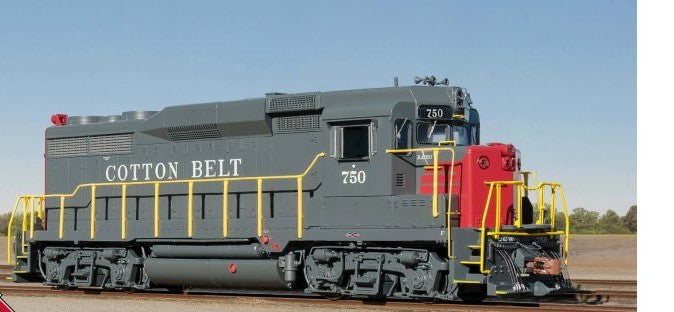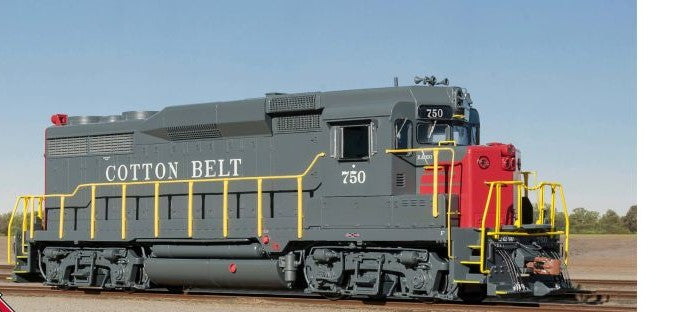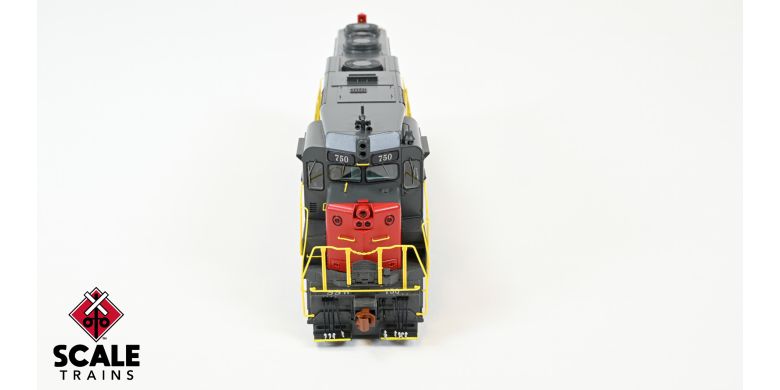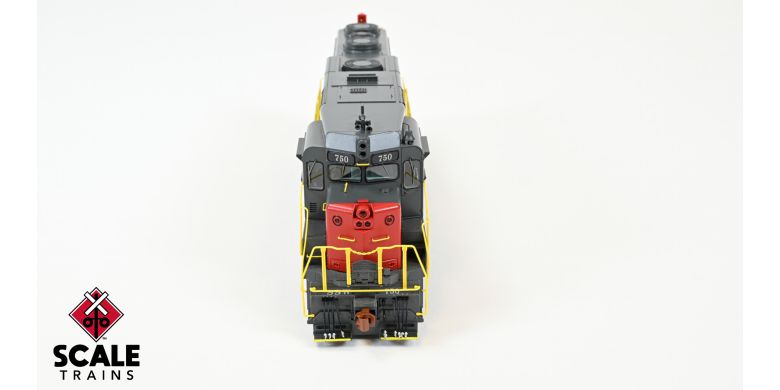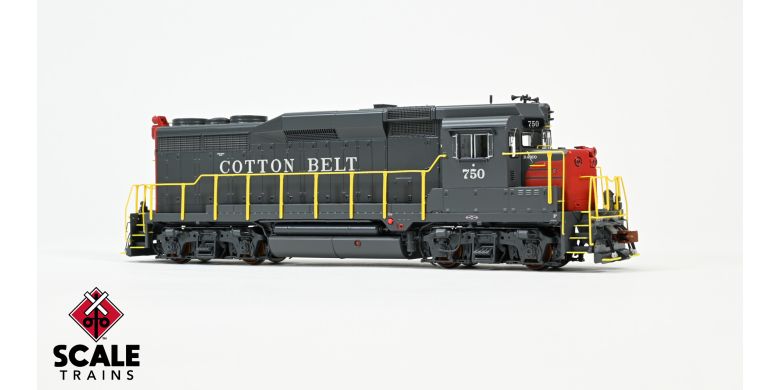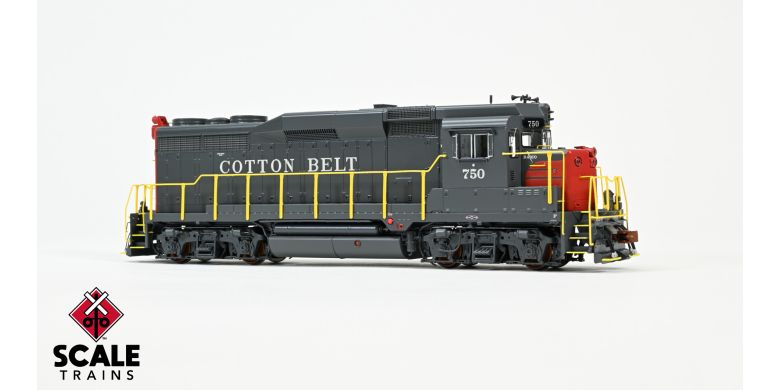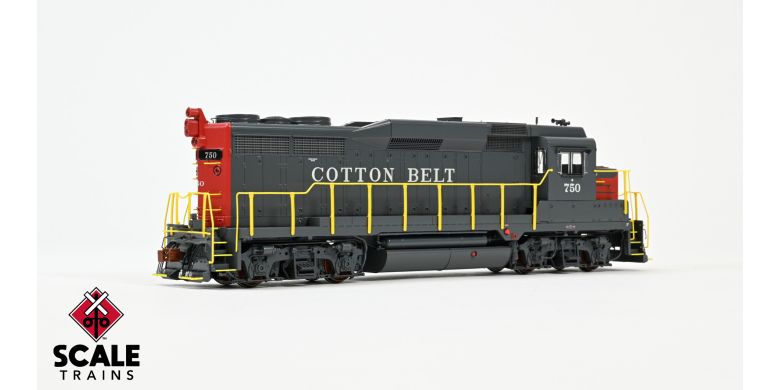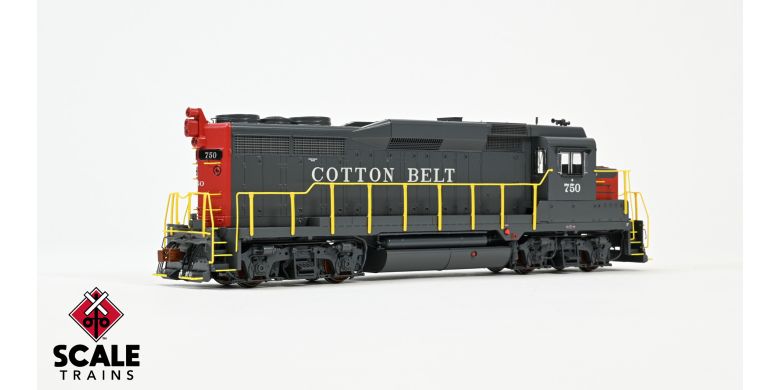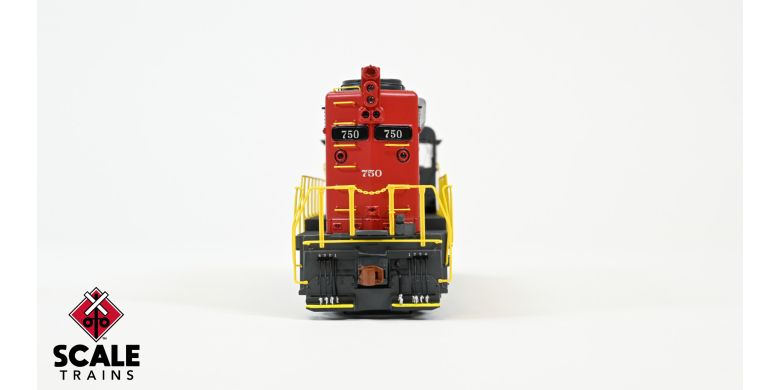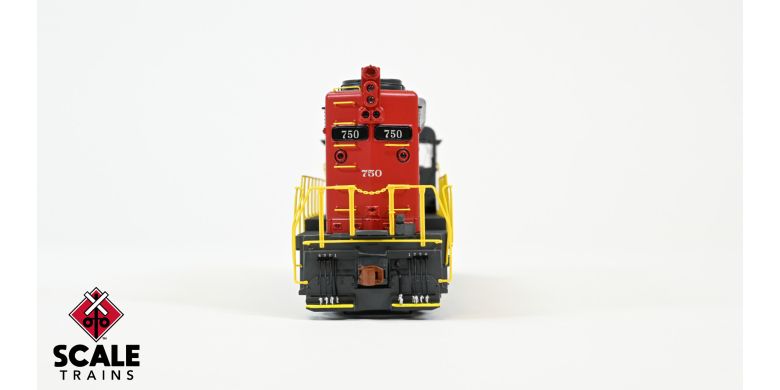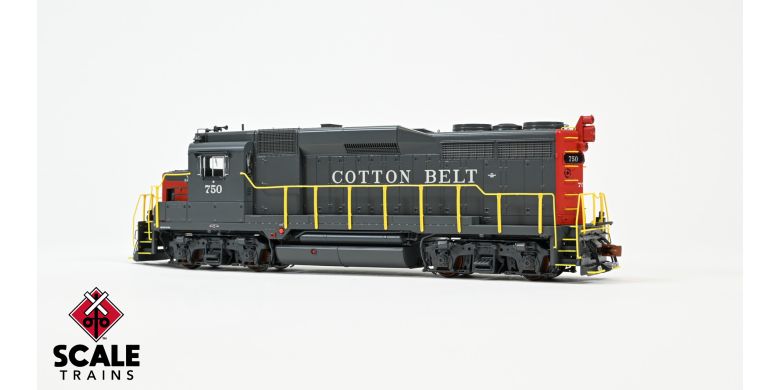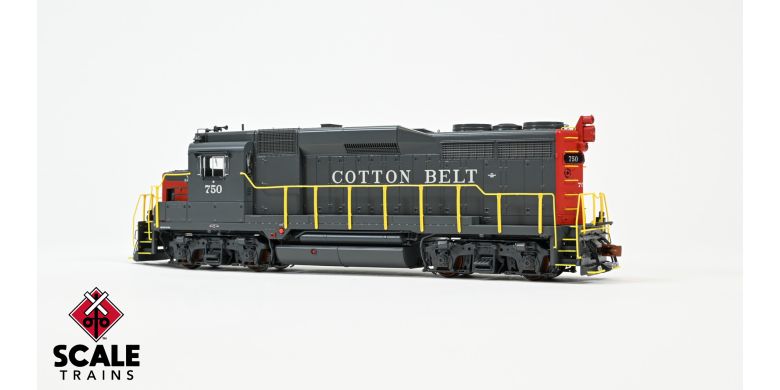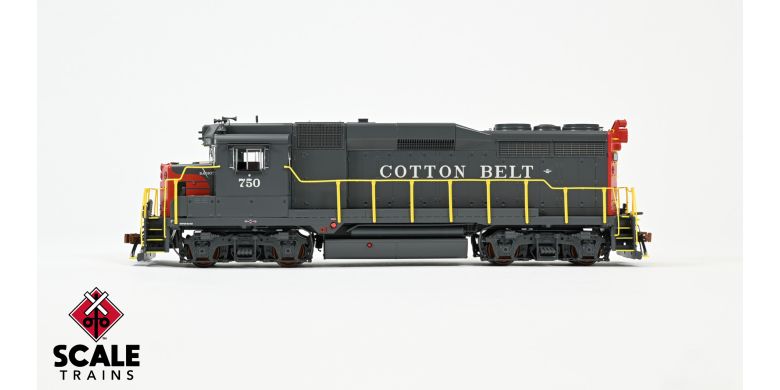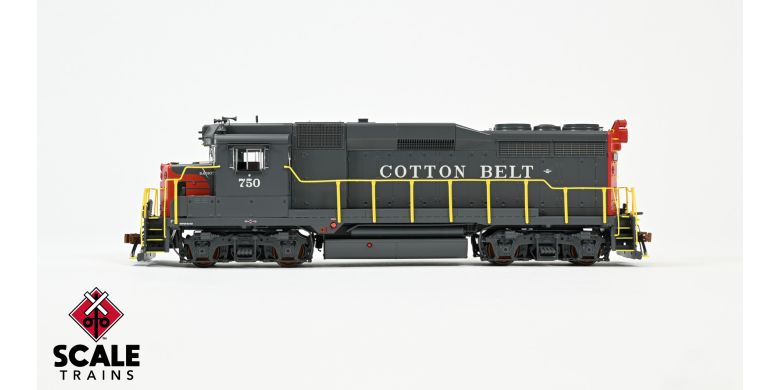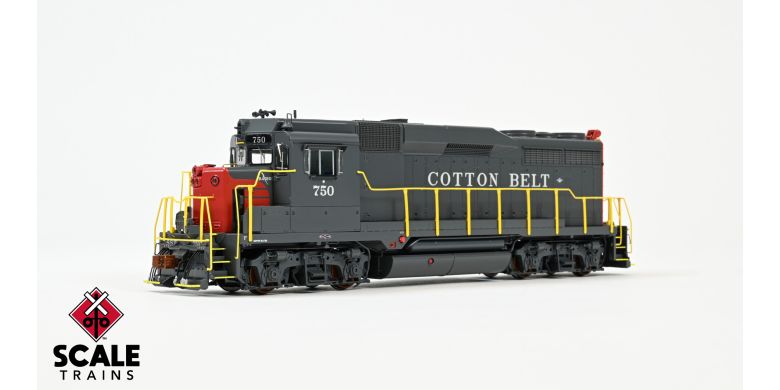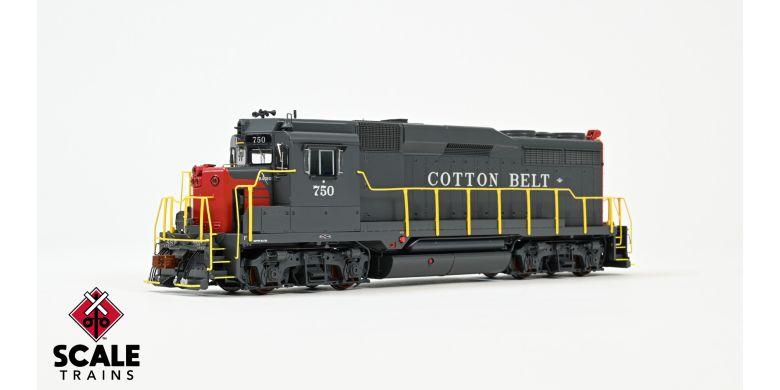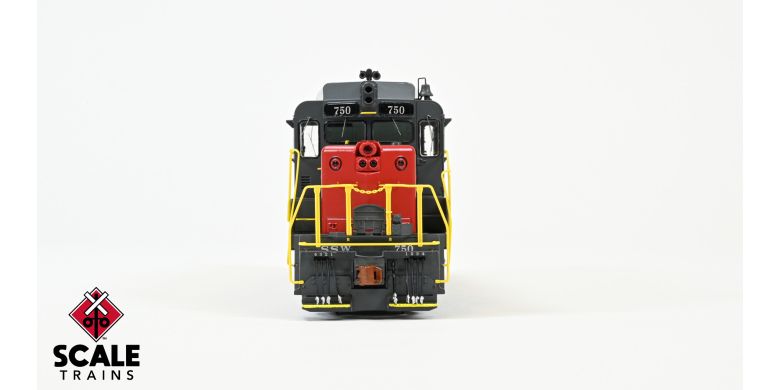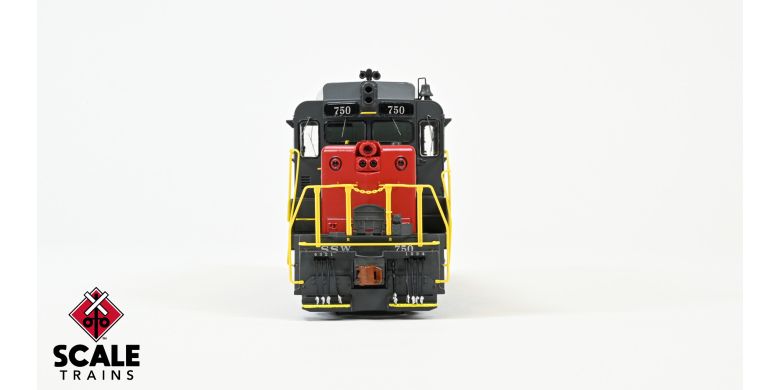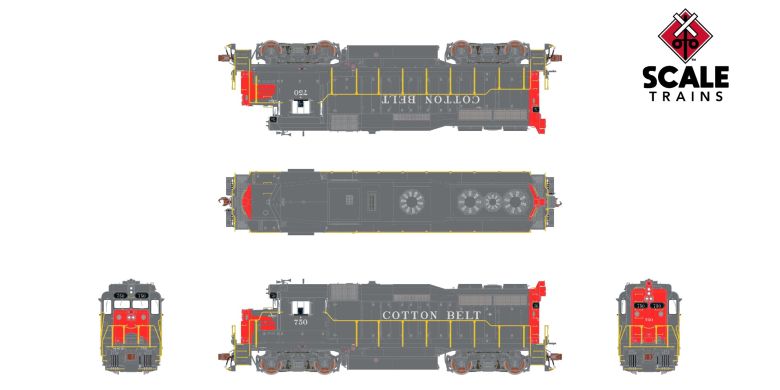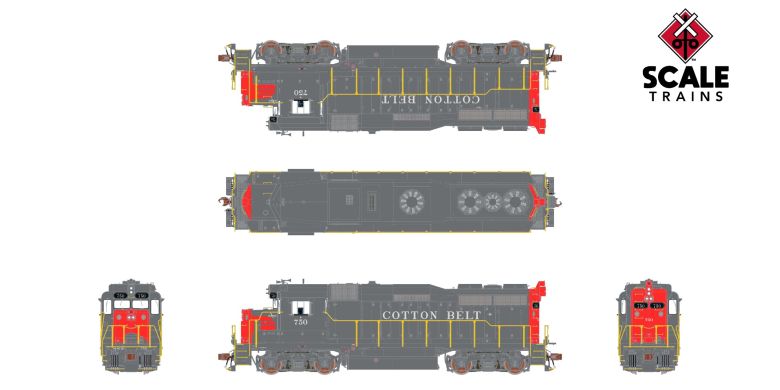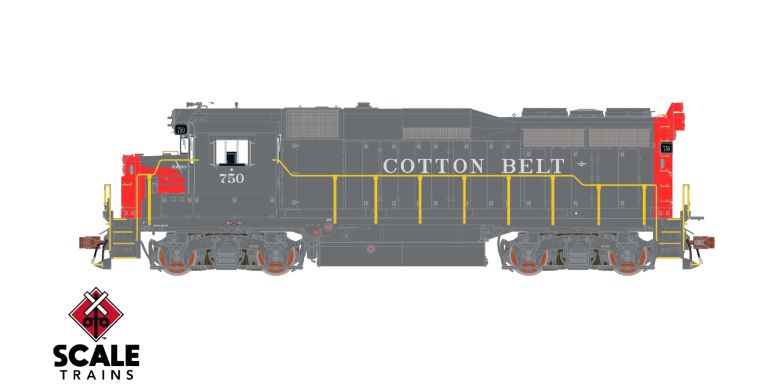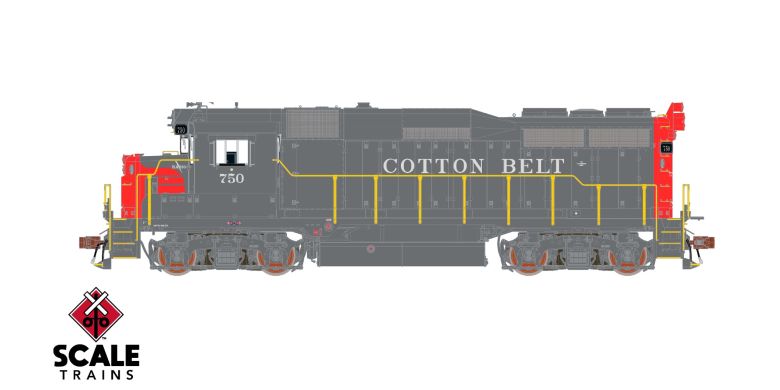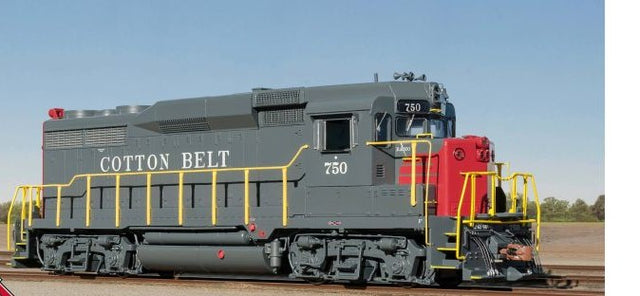ScaleTrains SXT39259 EMD GP30, SSW Cotton Belt/Bloody Nose/As Delivered #757 DCC & Sound HO Scale
ScaleTrains SXT39259 EMD GP30, SSW Cotton Belt/Bloody Nose/As Delivered #757 DCC & Sound HO Scale is backordered and will ship as soon as it is back in stock.
Couldn't load pickup availability
Description
Description
ScaleTrains Rivet Counter SXT39259 EMD GP30, SSW Cotton Belt/Bloody Nose/As Delivered #757 DCC & Sound HO Scale (Note pictures may show a different road number).
A new era continues with the Rivet Counter HO Scale EMD GP30. First introduced in 1961, the GP30 would become one of the most-common locomotives on the rails for the next two decades. Our Rivet Counter series model renders the numerous variations of cabs, dynamic brakes, doors, grilles, trucks, etc. Per the prototype and era, we’ve also incorporated LED lighting effects including front, rear, and side walkway lights; ground lights; printed and lighted number boards; and ditch lights. Learn more by clicking the “Product Details” tab below.
Road Number Specific ScaleTrains
- New road name
- Era: 1963 to 1965
- Series 750 to 759; built 2/63
- Fully-assembled
- Multiple road numbers
- Operating LED-illuminated ground lights on both sides of locomotive*
- Operating LED-illuminated “hemisphere” walkway lights on hood ends, and at end of raised walkway duct*
- Operating front and rear LED Pyle-National 20585 (Translite) “Gyralite” signal light*
- Operating front and rear Pyle-National Single Red Gyralite (“UDE Light”)*
- Operating LED-illuminated tricolor front and rear flush-mounted class lights with lenses and raised gaskets**
- Cab number boards and hinged rear number indicator housings
- Front and rear multiple unit (MU) hose catch boxes with footboards
- 4-hose multiple unit (MU) hose clusters with silver gladhands
- Semi-scale coupler buffer equipped with durable metal semi-scale Type E knuckle couplers
- Front and rear straight uncoupling levers without loop handles
- As-delivered pilot faces without uncoupling lever loop notches
- Deck-mounted multiple unit (MU) receptacle
- “Short” stepwells with see-through steps
- Handrail set with center gangway chains
- Front and rear standard drop steps
- Scale sectioned tread plate detail with EMD early “X” style pattern
- Stepwell/walkway gussets
- 81” GP30 low short hood with ratchet handbrake and square sand fill
- Hinged battery box doors with early hinges and narrow louvers
- Early cab sub-base doors with early hinges
- Front standard EMD LED-illuminated headlight with lenses on number board housing
- GP30 cab with increased length on left (fireman’s) side and inverted cab heater vents
- Detailed cab interior with separate floor, rear wall, seats, and standard AAR control stand
- No cab vents
- Sliding cab side windows
- Tall clear wind wings with mirror at bottom mounted fore of cab side window on both sides of cab
- SP/SSW sun awning
- Lost-wax brass cast Nathan P-3 (P24R1 configuration) horn mounted on right side cab eave
- Motorola ASP-16 “Firecracker” antenna mounted on the cab roof
- Accurate hood door and long hood detail
- Late single-panel inertial compartment
- Wire inertial air intake grills
- Tall turbo exhaust stack
- Standard-range dynamic brakes with 48” fan
- Early See-through dynamic brake intake grills with horizontal wires on top of vertical vanes
- 6-horizontal rib radiator intake grills
- See-through front and rear 48” radiator fan housings with 8-blade fans; 36” pan-top center radiator fan
- Curved radiator fan grab iron
- Square sand fill hatch on top of long hood end
- Rear LED-illuminated horizontal headlight with lenses
- Underbody frame rail with separate plumbing
- Detailed Blomberg-B trucks with Hyatt bearing housings; elliptical springs; end transom detail; separate sanding lines and brackets; and separate swing hanger detail
- Dimensionally accurate truck centers
- Speed recorder mounted to second axle on right front truck sideframe
- Cab-roof mounted “tripod” bronze bell with air line
- Prime air filter (can style)
- 2,600-gallon fuel tank with vertical gauges and fuel fill in sill skirt; round gauges in fuel tank sides
- Factory-applied wire grab irons, photo etched lift rings, windshield wipers, trainline hoses with silver gladhands, air tanks, sand hatch covers and more
- Motor with 5-pole skew wound armature
- Dual flywheels
- All-wheel drive
- All-wheel electrical pick-up
- Directional LED-illuminated headlights
- Printing and lettering legible even under magnification
- Operates on Code 70, 83 and 100 rail
- Packaging safely stores model
- Minimum radius: 18”
- Recommended radius: 22”
- DCC & sound equipped locomotives also feature:
-
- ESU LokSound 5 DCC & Sound decoder with “Full Throttle”
- Two (2) cube-type speakers
- 16-cylinder 567D3 prime mover sound
- ESU designed “PowerPack” with two super capacitors***
- Operates on both DC and DCC layouts
* Lighting features operate when using an ESU decoder with appropriate programming while operating using DCC
** During DC operation, class lights illuminate in white. Access to other colors and the ability to change colors requires an ESU DCC decoder while operating in DCC
*** Compatible with appropriately programmed ESU decoders while operating using DCC
The 1960s was a turbulent decade of change, home and abroad. Societal and geopolitical issues aside, another area of change was occurring on U.S. railroads. With the transition from steam to diesel largely complete, with hordes of first-generation diesel locomotives in service, the railroads were now looking towards increased horsepower to move increasingly larger and higher-priority trains. Reliability and maintainability were an increasing concern, based upon experience from cantankerous early designs that kept armies of repair crews busy tending to units laid up in backshops. Thanks to competition from the leading builders, revolutionary change was coming to the locomotive world.
As the leading locomotive builder, General Motors’ Electro-Motive Division (EMD) was riding high on the successes of recent designs of the time, such as the GP9 and SD9, their turbocharged successors, the GP20 and SD24, and fleets of streamlined E and F-units. EMD was poised for continued success, but a newcomer was nipping at their heels – General Electric. The longtime supplier of electrical components to locomotive manufacturers was looking into throwing their hat into the ring with an all-new locomotive design of their own, based upon extensive research, testbeds, and feedback from the railroads. The result was the U25B, which introduced the “sealed carbody” concept, where air was drawn into a centralized compartment where it was filtered, supplying cleaner air for the prime mover and auxiliaries. The carbody and main electrical control cabinet was also pressurized slightly, helping to keep out dust and other contaminants. Additionally, its horsepower rating of 2,500 eclipsed the 2,000hp of the competing GP20 from EMD.
The arrival of the U25B in 1959 and the interest it drew from the railroads meant EMD would revamp its designs to meet the challenge from the newcomer. The basic GP7/9/18/20 platform was stretched slightly to allow for a larger fuel tank for increased range and tractive effort. Having proven the advantages of turbocharging in the predecessor GP20, the turbocharged 16-567 prime mover was retained, though receiving a slight boost to 2,250hp. The biggest change came in the carbody design, which featured an all-new main electrical cabinet at the rear of the cab, which drastically changed the cab height and profile in comparison to the GP20. EMD would also introduce a centralized air system as well, with an inertial air intake and filtration system to provide clean pressurized air to the locomotive. And in an unusual twist, EMD engineers would turn to parent GM’s automotive styling department to help blend all of these new features into the carbody.
The result of all of these design features was the GP22. With its model number falling in line with its horsepower rating and EMD’s numbering system at the time, this new demonstrator locomotive for 1961 looked like no other in the EMD lineup. The taller electrical cabinet, combined with the styling input from GM, created a “humpback” from the cab back, extending into the inertial air filter compartment, ending in fairings that straddled the roofline and concealed optional dynamic braking equipment. Coming with a low-short hood as standard, the cab face featured a “vee” profile, offering improved visibility and reduced glare for the crew. The cab front roofline was set back in a unique brow, and the flat cab roof rolled gracefully down on each side into a stepped fairing, all blending into the long hood roofline.
The demo unit, numbered 5629, quickly set out to prove its capabilities and features to the railroads. But before long, EMD would re-designate its new general-purpose unit the “GP30”, mainly as a marketing move, the rationale being the model number “30” being greater than the “25” of the competition. They would also tout “30” design features and improvements over previous models. This change, along with a return trip to LaGrange for a new demonstrator paint scheme and some styling tweaks to the carbody that would give it the definitive GP30 “look”, would set the stage for the GP30’s arrival on the railroad scene.
The GP30 would prove to be a winner for EMD, outselling the upstart U25B nearly 2:1, with examples being sold to most major railroads of the era by the time production ended in 1963. The largest original GP30 owner was Union Pacific, acquiring a total of 112 standard GP30s, and 40 cabless GP30Bs, the only owner of that type. These cabless units came in two distinct groups; standard GP30Bs intended as freight booster units, and steam-generator equipped GP30Bs meant for passenger duty, typically trailing behind SDP35s on secondary trains, such as troop trains of servicemen embarking to the conflict brewing in Southeast Asia in the mid-1960s. Taking second place for largest new GP30 owners was Southern Railway, acquiring 120 examples, and continuing with their longtime practice, came equipped with EMDs optional high short hood. Norfolk & Western would be the only other purchaser of GP30s with this option, with all other owners preferring the standard low short hood and cab-front operational configuration for improved visibility.
Western giant Santa Fe would purchase a sizable fleet of GP30s as well, with 85 units delivered in their resplendent blue and yellow “Bookend,” or “Pinstripe” scheme. Western rival Southern Pacific, oddly enough, barely dipped their toe in the GP30 waters, only buying a total of 18 between them and their Cotton Belt subsidiary, but being some of the most distinctive units built on account of being optioned with the unmistakable SP lighting package on both ends. Rio Grande would purchase a slightly larger fleet of 28 units, and C&NW’s order lacked dynamic brakes, as was their custom at the time (L&N would also buy GP30s lacking this feature). Pennsylvania Railroad was another GP30 customer, and their units would rival the SP/SSW fleet in terms of “hard to miss” visually, coming equipped with their innovative “Trainphone” radio equipment and carbody antennas on the long hood roof. The smallest as-built fleet of GP30s belonged to Canadian railroad Canadian Pacific, which purchased two units, built by EMD’s Canadian Subsidiary, General Motors Diesel (GMD), and featuring slight differences from their U.S. brethren on account of slightly different construction practices and materials, in addition to the uniquely Canadian options preferred by CP.
As with just about every other locomotive produced by EMD, the GP30 would also undergo small production tweaks to the basic design during its production span, dubbed as production “phases” by locomotive enthusiasts, reflecting improvements made to improve serviceability, performance, or ease of construction. While most of the changes to the basic GP30 design were fairly benign, such as changes to the inertial intake grill pattern, radiator intake gills, dynamic brake intake vanes, and access panels for the inertial air compartment behind the cab, the most noticeable change was to the cab, at the request of Union Pacific. To accommodate 3-person crews consisting of engineer, conductor, and head brakeman riding on the locomotive, UP asked EMD to enlarge the cab, which they did by lengthening the left side of the cab by several inches, allowing space for a third seat on that side of the cab. This also resulted in the deletion of a handrail stanchion that was immediately behind the cab on the left side, providing another spotting feature besides the increased cab length aft of the side window opening. This special request went on to be a standard feature on GP30s built from late 1962 onward.
All in all, GP30 would prove to be a success for EMD, helping them hold on to their status as the number one builder in the country, and more importantly, help their railroad customers move freight … and in the case of UP’s GP30Bs, passengers. Most of the various fleets of GP30s across the U.S. and Canada would have long careers, for their original owners, and in many cases, successors due to mergers, bringing even more color to the varied GP30 palette. Various fleets would be distilled down into new owners such as Conrail, Burlington Northern, and Chessie System, as the units toiled on over the years, with many being bumped down into less demanding duties off of the mainline as the years and mileage racked up. One Achilles’ Heel of the GP30 was its complex electrical system, which would give more than one railroad electrician a headache trying to diagnose ground relay faults or other maladies amongst its complex system of relays and switchgear; even its higher-selling successor, the GP35, was to suffer similar issues with its just-as-complex electrical system.
Seeing as the basic design was sound, many railroads would embark on rebuilding programs to try to cure their GP30s of some of those chronic ills. Chessie System would rebuild many members of its inherited B&O/C&O fleet, dubbing the rebuilt units “GP30M”, and were not afraid to send them all over the system on all types of assignments. In fact, some examples of these rebuilds have been documented in run-through service on the Southern Pacific in the 1990s, as far away from home as Southern California, while operating as assets of Chessie successor CSX.
Ultimately, CSX would embark on yet another transformation of their GP30 fleet, rebuilding many into road slugs, classified as “RDMT” (short for RoaD MaTe). Their prime movers and main generators were removed and replaced with concrete ballast, and any other feature needed for its operation as an independent locomotive — hood doors, radiator fans, exhaust stack — were removed and plated over. Like any other railroad “slug”, these units were dependent upon a “mother” unit, in this case, specially-equipped GP40-2s, coupled to it to provide electrical power for its traction motors. These units were popular with crews for their quiet ride, and low-speed lugging ability that was the reason for their existence. These rebuilds would last until the late 2010s, before age and changes in railroad operating practices would sideline them.
Meanwhile, Southern Pacific, famous for its extensive locomotive capital rebuild programs at their Sacramento Shops throughout the 1970s and 80s, cautiously dabbled with a rebuild program for their small GP30 fleet, sending a single unit to Sacramento to be stripped down and evaluated. Sadly, the potential “GP30R” program wasn’t to be; between budget constraints, and the extensive changes that would have been needed to bring the GP30’s relatively oddball equipment layout in line with more contemporary units, the GP30 rebuild program died before it got off the ground, with their small fleet ultimately being retired by the mid-80s.
Neighbor Santa Fe, on the other hand, themselves no stranger to locomotive rebuilding, decided to embark on a rebuild program on their fleet, dubbing the resulting product the “GP30u”. The units were renewed inside and out, and the most distinctive feature of most of the rebuilds was the elimination of the cab front “vee”, giving the center portion of the cab face a flat front. The rebuilt units were true jacks-of-all-trades, and could be seen in all kinds of service, from lowly locals and yard switching jobs, to locking couplers with gleaming new Santa Fe “Superfleet” C44-9Ws on high-priority intermodal trains streaking across the southwest.
Finally, some of the most distinctive GP30s were to be found on the Burlington Northern. They had a sizable fleet of units inherited from merger partners Great Northern and the Chicago, Burlington & Quincy, and found GP30s useful for many intermediate chores. So much so, in 1990 they embarked on an ambitious rebuild program that would rebuild most of their fleet, as well as used GP30s (and GP35s) acquired from across the country. Three different vendors — VMV Enterprises, EMD, and Morrison-Knudsen — were contracted for the program, with the resulting product designated as a GP39, with a suffix added at the end to denote who did the work; GP39E for EMD, GP39M for Morrison-Knudsen, and GP39V for VMV.
These medium-HP rebuilds were brand-new for all intents and purposes, with the prime movers upgraded to 2,300hp 16-645 specs, an AR10 alternator replacing the original D32 generator, and a new Dash-2 electrical control cabinet replacing the troublesome original. While the GP30s rebuilt by VMV and M-K kept their signature GP30 appearance, a group of former Southern high-hood units would have the entire cab and nose assembly replaced with a newly-fabricated EMD “Spartan” style cab and low hood, whose dimensions and utilitarian appearance clashed with the graceful curves and “humpback” of the GP30 carbody. Appearances notwithstanding, these rebuilds were a success, providing BN with needed medium-HP units suitable for a variety of assignments, with many remaining in service to this day with successor BNSF.
Some 60 years after first rolling out of the main erecting hall at La Grange, that so many GP30s can still be found in daily service speaks volumes to the ruggedness and adaptability of the design. The GP39E/M/V rebuilds of BN successor BNSF Railway are the sole Class 1 GP30s (if at least the carbodies) still in service, the CSX RDMT slugs having been retired within the past few years. Those aside, there are still a handful of more-or-less “original” GP30s to be found on shortlines across the country, as well as examples preserved in museums. A few museum examples include Southern Railway 2601 residing at the North Carolina Museum of Transportation, which was one of the units photographed and measured for the all-new ScaleTrains model. Another example is Union Pacific 844 (almost as famous as its steam-driven cousin on the UP roster), which sees regular service pulling excursion trains at the Nevada State Railroad Museum, and which was also photographed, measured, and LIDAR scanned for the project. Thanks to EMDs solid design, as well as the preservation efforts of those in museums, one of the most distinctive diesel locomotive designs of all time will be around for years to come for future generations of railfans to enjoy.
RAILROAD HISTORY
The late 1950s marked a transformative period for American railroads as advancements in motive power technology reshaped the landscape. General Electric's (GE) introduction of the 2,500-hp U25B in 1959, with innovations like a sealed carbody and a centralized air intake system, triggered a paradigm shift. In response, competitors like Alco also entered the scene. EMD, known for its GP20 model, faced the challenge of maintaining its market edge. Engineers at EMD turbocharged the 567 series engine to enhance the GP20's 2,000-hp output. Simultaneously, carbody designers collaborated with General Motors' automotive design group to create a visually distinctive locomotive. In 1961, EMD unveiled the GP30, a 56-foot, 2-inch long road unit with a unique cab profile and a 16-cylinder 567D turbocharged engine rated at 2,250 hp.
The GP30's sleek design featured a sweeping roof, departing from EMD's traditional arc-shaped roofs. Despite the modest power increase compared to competitors, the GP30 offered proven dependability. It introduced improvements like a sealed electrical compartment, enhanced wheel-slip control, higher capacity traction motors, and an inertial-style air filtration system. With 948 units sold to 29 North American railroads by the end of 1963, EMD demonstrated its market dominance in the second generation of diesel-electric locomotives. The GP30's success was attributed to EMD's reliability record and a marketing strategy that cleverly assigned it a higher numerical designation than its competitors.
Santa Fe, despite purchasing some GE U25Bs, remained loyal to EMD due to the latter's proven reliability. In 1962 and 1963, Santa Fe acquired 35 GP30s, numbered 1200–1234, followed by an additional 50 units (1235–1284) a year later. They were delivered in the gorgeous blue and yellow “pinstripe” scheme, first used in 1952. Until that year, non-passenger diesels of the Santa Fe were delivered in a classic Black with Silver stripes, or for F-3/F-7 models, in the iconic Blue and cream colors, complementing the wartime 40's FT locomotives.
The significant shift in 1952 involved replacing the previous "cream" yellow with the rich gold yellow that adorned the passenger engines. This alteration marked a visual unification across Santa Fe's diesel fleet, creating a more cohesive and recognizable appearance. While officially referred to as the "1952 paint scheme," it quickly gained a colloquial nickname among railroad enthusiasts as the "pinstripe" scheme.
The name "pinstripe" likely originates from the fine, elegant lines that adorned the locomotives, resembling subtle pinstripes on a suit. This design featured a predominantly gold-yellow body with a distinctive black pinstripe running along the sides of the locomotive, accentuating its streamlined contours. This new look became an iconic representation of Santa Fe's modern diesel fleet, symbolizing the railroad's commitment to both functionality and aesthetics.
Despite its official designation, the railroad staff in the Atchison office commonly referred to this paint scheme as "Yellow Noses," emphasizing the prominent yellow color on the locomotive's nose. This naming convention highlighted the visual impact of the gold-yellow color at the front of the locomotive, making it easily identifiable from a distance.
The pinstripe scheme remained a hallmark of the Santa Fe Railway's locomotives until 1972 when it underwent another transformation. Over the years, the "pinstripe" or "Yellow Noses" scheme became an enduring symbol of Santa Fe's diesel era, representing a blend of tradition and modernity on the rails.
By mid-1970, these GP30s were renumbered into the 3200-series. Approximately a decade later, after undergoing rebuilding and redesignation as GP30u, surviving units were incorporated into Santa Fe's 2700 class. Following the 1995 merger that formed BNSF, a significant portion of these units continued their service under the new railroad company, showcasing the enduring legacy of the Santa Fe Railway's EMD GP30s.
Specifications
Specifications
-
Scale-
-
Product Type-
-
Height
-
Width
-
Depth
